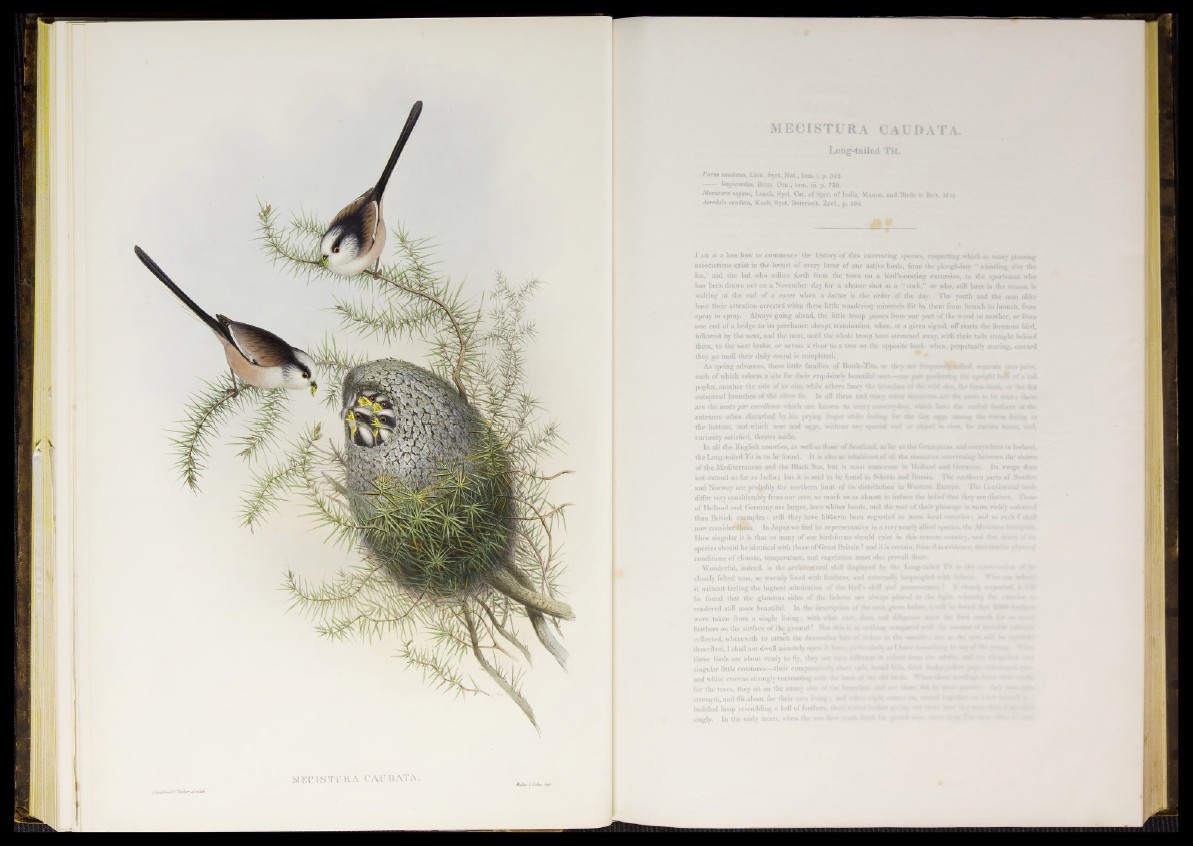
MECI STURA CAUDATA.
Long-tailed Tit.
Parus caudatus, Linn. Syst. Nat., tom. i. p. 342.
longicaudus, Briss. Om., tom. iii. p. 750.
Mecistura vagata, Leach, Syst. Cat. of Spec, of Indig. Mamm. and Birds in Brit. Mus.
Acredula caudata, Koch, Syst. Baierisch. Zool., p. 200.
I a m at a l o s s how to commence the history o f this interesting species, r e s p e c t i n g which so many pleasing
associations exist in the breast o f every lover of our native birds, from the plough-boy “ whistling o’er the
lea,” and the lad who .s a l l i e s forth from the town on a bird's-nesting excursion, to the sportsman who
has been drawn out on a November day for a chance shot at a “ cock,” o r who, still later in the season, is
waiting at the end of a cover when a battue is the order o f the day. The youth aud the man alike
have their attention arrested when these little wandering minstrels flit by them from branch to branch, from
spray to spray. Always going ahead, the little troop passes from one part of the wood to another, o r from
one end of a hedge to its perchance abrupt termination, when, at a given signal, off starts the foremost bird,
followed by the next, and the next, until the whole troop have streamed away, with their tails straight behind
them, to the next brake, or across a river to a tree on the opposite bank, when, perpetually moving, onward
they go until their daily round is completed.
As spring advances, these little families o f Bottle-Tits, as they an- frequently «vdled, separate into pairs,
each of which selects a site for their exquisitely beautiful west—-owe pair preferring tbe upright bd e of a tail
poplar, another the side o f an elm, while others fancy the branches o f the wttd aloe, tbe f tm t h—h, o r tbe thtr
outspread branches o f the silver fir. In all these and many other n to stinw are the nests to be w n ; these
are the nests par excellence which are known to every coontry-boy, which hose the curied ÜMtfiM» at the
entrance often disturbed by his prying finger while feeling for the tiny eggs among the wan» lining at
the bottom, and which nest and eggs, without any special end or object in view, he carries home, and.
curiosity satisfied, throws aside.
In all the English counties, as well as those o f Scotland, as far as the Grampians, and everywhere in Ireland,
the Long-tailed T it is to be found. It is also an inhabitant o f all tbe countries intervening between the shores
o f the Mediterranean and the Blade Sea, but is most numerous in Holland and Germany. Its range does
not extend so far as India ; but it is said to be found in Siberia and Russia. The southern parts o f Sweden
and Norway are probably the northern limit o f its distribution in Western Europe. The Continental bird*
differ very considerably from our own, so much so as almost to induce the belief that they are distinct. Those
o f Holland and Germany are larger, have whiter heads, and the rest of their plumage is more richly coloured
than British examples : still they have hitherto been regarded as mere local varieties ; and as such I stall
now consider them. In Japan we find its representative in a very nearly allied species, tbe Mecistura :. .v
How singular it is that so many o f our bird-forms should exist in this remote country, and ta«m <»f h»
species should be identical with those o f Great Britain ! and it is certain, from this evidence, that a in ta r fdbymmi
conditions o f climate, temperature, and vegetation must also prevail there.
Wonderful, indeed, is the architectural skill displayed by the Loug-twied Tif n
closely felted nest, so warmly lined with feather», and externally bespangled with befcetv Who cao Mw*
i t without feeling the highest admiration o f the bird’s skill and pe.rwverwjee ?
be found that the glaucous sides of the lichens are always pfatccd to A* hgh*. wbeaeay the es
rendered still more beautiful. In the description oi the im*»c, given below, «.
were taken from a single lining; with what care, tmem, and diligence must ta r m™
feathers on the surface o f the ground Î But this is an «othrag compared wvti
collected, wherewith to attach the decorative bu* M &ahm to the oufwir . i
described, I shall not dwell minutely upon it hen-, jMtdtatarif as I ha** swmtfthing to sagal
these birds are about ready to fly, they are nwy iWfcunt » « d e a r fr« a the ndflfli. ■
singular little creatures—their comparai - > --H s ta r t iadta hr*md thick ï&y-jy.few g*
and white crowns strongly contrasting with d
for the trees, they sit on the sunny side of the branche» m
strength, and flit about for their own i’mrig ; and *
huddled heap resembling a ball o f feather*, the»? wotta!
singly. In the early morn, when tbe »*•» firs* ■ :• irirth là»